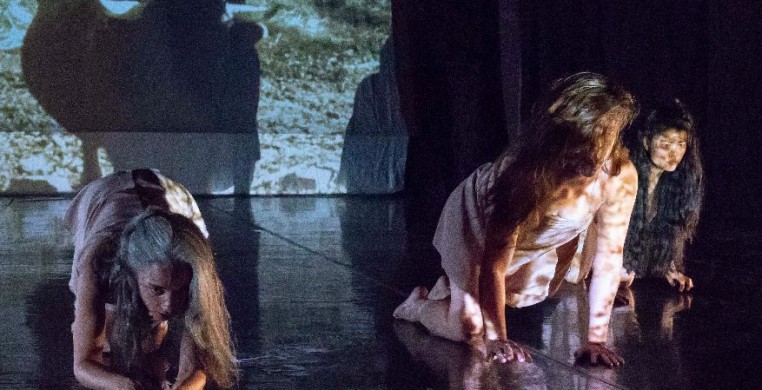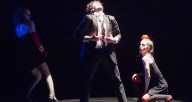I was back at the Hamlin Park Theatre last weekend for “Dance Shelter 2018” produced by The Chicago Moving Company (CMC). This year featured works-in-progress by CMC artists-in-residence Rachel Bunting/The Humans and Ayako Kato/ Art Union Humanscape as well as a re-staged work by guest artist Emma Draves, and a “re-imagined” piece originally choreographed by CMC founder Nana Shineflug. All-in-all it was a solid evening of post modern dance; no intermission, no muss no fuss.
Bunting is a curious dance maker. This assertion may say more about me than it does about her, but it is based on a perception that she has a wild and incongruous imagination. Her work incorporates multiple visual elements—projections, masks, props, and costumes—that often reference animals and environments that are sort-of recognizable but are ultimately mythical. Sound is used as an ambient clue and dance is incorporated as the medium through which the “beings” in her work—I can’t always assume the “beings” are human— function and communicate. Her work follows its own logic, like poetry or Twin Peaks. And sometimes it feels like the strangeness doesn’t go anywhere, it just stays strange and never evolves. But I generally dig all the half-lucid abstraction. I am often left feeling a combo of confusion and amusement after Bunting’s performances. I smile to myself as I wonder why she puts certain images—like cattle, crystal, and wine—together: her choices being so bizarre and fantastical. Such was the case with her latest experiment, “SUNS: She-Wisdom.”
The three dancers in this piece—Bunting, Precious Jennings, and Helen Lee—emerged from darkness each wearing light-up headbands (magenta, yellow, and blue) that guided their way around the stage. Floating around like fireflies at dusk, the glowing orbs were magical and the dancers’ ample free-flowing hair made me think of nymphs or fairies. They were busy placing crystal bowls and vases around the space while holding flowers in their hands. Meanwhile, singer/performer Katya Lysander crawled her way on stage from the audience risers. These were the opening images.
At some point the dancers stood in a line mid-stage and poured liquid into their respective bowls, one pouring wine, another milk, another water. At another point they crawled on hands and knees towards these vessels and lapped up the liquid like cats. Another moment had Lysander singing a hearty, Eastern-European-sounding folk tune, and later we heard a rather raunchy recording of a farm animal bellowing and snorting. The dancers flung their arms, legs, and hair around during some phrase work on the floor, and eventually a video projection of cows in a corral with what appeared to be a ton of mud and crunchy brown leaves scattered underfoot.
The choreography during this video section was the most compelling of the piece. In a tight-knit trio the dancers executed quick, staccato jabs with their legs, arms, and torsos. They circled and weaved around each other with exciting relative timing; each dancer responding to the move of the next. The video projection appeared on their skin and flesh-colored clothing (costume design by Collin Bunting) which amplified the urgency and mashed-ness of their dancing. If Bunting intends to continue with this work-in-progress, she might start by developing this section. The rest of the elements will, no doubt, continue to appear and perplex at random but the glue to the work might just be found in this compelling physical material.
Fellow resident artist, Ayako Kato, performed a new solo entitled “eyes.”
Set to some pleasantly jaunty piano music (not credited in the program), Kato performed with contrasting somberness. Wearing a dark navy tunic atop equally dark leggings, I wondered if she was actually in mourning. But there was also a sly whimsy in the work. She has spent countless hours in the Hamlin Park Theatre and we know how stir-crazy people can get within familiar walls. This piece had some of that feeling, like she was intentionally kicking around and messing with the space’s idiosyncrasies. She hid behind the curtains, cloaked herself with them, and flung them out of position. She crumpled flower petals in one corner of the stage, tossed an apple into the center of the space, and then rolled out a seen-better-days chair. These antics were broken up by luscious and articulate movement. Pausing in the midst of play, she sank into herself briefly letting her kinetic energy percolate. Then she exploded into a string of movement driven by a deep, internal impulse. That’s the thing about Kato as a performer; when she gets in a groove dancing, she is on fire. As a highly skilled improviser, she knows how to follow her physical instincts and she rides them to the exact right moment of fruition. The theatrical moments in her work that surround these physical grooves provide some context but they can be hit or miss in terms of their power to provoke. Her dancing, on the other hand, is always nuanced and spectacular. I have yet to see her translate that particular strength as a movement practitioner on to fellow dancers; she really excels as a soloist. Let’s hope she keeps working on “eyes.” There are excellent kernels in this work worth developing.
“Approaching 9,” originally choreographed by Nana Shineflug (with the original cast of dancers) was presented as part of CMC’s new “Echo Project”. According to the program notes this project is a “multi-year undertaking re-imagining and reverberating [CMC] repertory work through different casts, sites, and communities.” This is a cool idea and the first iteration turned a dance that was originally a trio into a solo performed by Chih-Hsien Lin. Reworking a pre-existing dance on new performers, configurations and circumstances sounds like a dream job for (fellow) dance/composition nerds and it’s a creative way to honor the legacy of a deceased choreographer. While “Approaching 9” was not ground-breaking, Lin is a terrific performer. She walked the stage in circular floor patterns pausing in certain locations to execute clean-lined choreography reminiscent of iconic post-modernists (think elementary Trisha Brown). Supple and firm in her stage presence, Lin carried the work with maturity and intrigue.
The final piece of the evening was Emma Draves’s “The TransPenine” with a cast of nine, mostly femme, mostly inexperienced dancers dressed in shades of white. While variations on unison, flow-y, hyper-emo dance phrases ensued, I found myself day dreaming about what would become of these young dancers. How many of them would stay committed to this field? Who would eventually find themselves too busy with their moneymaking gigs to make time for rehearsals? It takes a deep understanding of the “long-game” to keep going as a dancer and dance maker. Perseverance is an understatement. Draves understands this perspective and has been working in the field for years. She has made particularly interesting work this past year, however this piece missed the mark. In its attempt at drama—meaningful stares at the audience, heavy pauses, sentimental sound (designed by Bob Garrett)—the stage became a wash of vapidity. There was nothing to grasp onto as a viewer, no defining moments of clarity or intention. Hence, my wandering mind…
Sometimes we nail it, sometimes we don’t. But the people (like Draves, Bunting, and Kato) who keep showing up and doing the work decades later, will always be the ones to watch.


